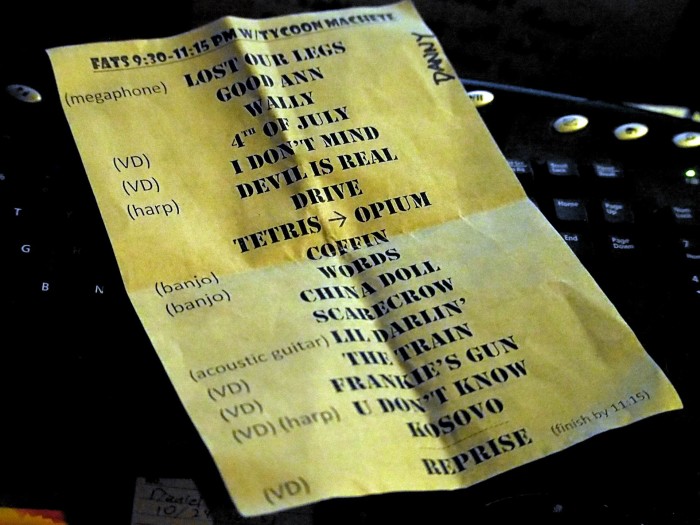It’s basically rune-paper of future-sight.
Please Remember:
The opinions expressed are mine only. These opinions do not necessarily reflect anybody else’s opinions. I do not own, operate, manage, or represent any band, venue, or company that I talk about, unless explicitly noted.

 Want to use this image for something else? Great! Click it for the link to a high-res or resolution-independent version.
Want to use this image for something else? Great! Click it for the link to a high-res or resolution-independent version.Some of the best bands I work with have never, and probably will never hand me a set-list. This is important for me to say, because I otherwise might give the impression that bands who don’t hand set-lists to audio-humans are falling short of being professional. That’s not what I’m trying to get at.
What I AM trying to say is that providing a PA driver with a set-list, especially an annotated one, can be a very good thing for everybody. When well done, a document such as the one pictured is actually very powerful. When you get right down to it, what you’re providing a sound craftsperson is something that you might only expect to find in the fantasy worlds of JRR Tolkien or D&D:
A set-list is, for all practical purposes, a low-level, magic scroll of foreknowledge and telepathy. It grants people like me a bit of prescient vision into what you’re going to do next, and this can be a nice enhancement to your show.
If an audio operator knows what’s going to happen, they can anticipate the event and be “right there” when it’s time, instead of having to catch up. There’s less chance of an awkward delay between something needing to be addressed and the appropriate action taking place, because the audio-human can address the issue (or be ready to do so) without the issue having happened first. “Scrambling” can be greatly reduced by the application of a well-formed set-list.
Examples
The set-list pictured above is clean and organized, and it also packs an enormous amount of “procedural information” into a small space. All that’s required is for me to interpret it correctly for the specific situation. For instance…
“Megaphone” – This is going to be loud, band-limited, and the loop gain through the megaphone may contribute to feedback problems. Be ready to deal with that.
“VD” – Vincent D, who’s sitting in with us, is going to have prominent vocals on this tune. If you’ve pulled him down to save loop-gain for other things, you’ll need to be prepared to push him back up and otherwise adjust.
“Harp” – There are prominent harmonica bits in this tune. Be thinking about where to put the fader for those.
“Banjo” – This instrument is not going to sound the same as the guitar that’s normally plugged into that amplifier. You might need to pull some fast work with your channel EQ if things are really out of whack, and you might also need to “get on the gas” with the fader.
“Acoustic Guitar” – This is plugged into that direct box which you’ve connected to a channel that is currently muted. You’re going to need to unmute that channel, or things will be awkward for a minute.
The other thing about that little piece of paper is that it tells me an expected start and end time. This is great, because I don’t have to wildly guess at when the band will go on, nor do I have to speculate about how long they’re planning to go on. They’ve told me. (This is also an indicator of Hectic Hobo’s professionalism. They have a plan regarding their spot in the lineup, and they’re going to try to stick with that plan so that Tycoon Machete gets to utilize their slot to the fullest.)
Making Your Own
If you decide that you want to provide your friendly, neighborhood noise wrangler with a set-list, I can give you a few pointers as to what works best:
- Maximize your simplicity. Try to find the most basic way possible to convey the information you want to convey. Color coding, for instance, IS neat, but if I need to consult a “map key” to remember what all 20 of your colors mean, you may be getting in your own way. (Also, some folks are colorblind, and colors are harder to discern in low-light. See below.)
- Make things highly readable in low-light. Big, blocky, and simple fonts, plenty of “whitespace,” and generally high-contrast help with this in a big way.
- Avoid skimping. If you think something’s important, include it. If that means printing out several sheets in order to play nicely with the first two points, so be it.
- Don’t take offense. Some audio-humans won’t seem to care about your show, or your set-list. Give them the opportunity to care. Maybe they will. If they don’t, at least YOU tried.
For those of us who do care, and do read set-lists, I can tell you that being able to partially read your mind and see a little ways into the future is a super-spiffy power to have. A little bit of paper from you can grant that power.